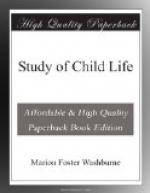[Sidenote: The Mother as Teacher]
Feeble as her own knowledge may be, a mother has certain advantages as a teacher of her children over any but the exceptional Sunday school teacher. For, first, she knows the children, and, knowing them, knows their needs. Secondly, she knows their daily lives and continually during the week can point out wherein they fail to live up to their Sunday’s lesson. And again and most important, she loves them tenderly, and from love flows wisdom. Usually the mother gives her own children a love far beyond that given by anyone else, and this deeper love sharpens her intellectual faculties and makes her both a keen observer and a good tactician. Giving her children some simple lesson on Sunday afternoon, she finds a hundred opportunities to make the lesson living and vital to them during the succeeding week.
[Sidenote: Religious Enthusiasm]
In the early years of the child’s life, the mother is usually the one to decide whether he shall attend Sunday School or not, but as he approaches adolescence he is likely to take the matter in his own hands, and if it happens that some revivalist or a new stirring preacher comes in contact with his life at this time, he is very likely to be swept off his feet with a sudden zeal of religious enthusiasm, which his mother fears to check. The reports of memberships, baptisms, etc., show that a large number become converted and join the church during adolescence. While this does not in the least argue that the conclusions that they reach at that time are therefore unsound—for adolescence is not a disease, nor a form of insanity, but a normal, if excitable, condition—still it does prove, when coupled with the further fact that in adult life these young converts often relapse into their previous condition, that a more lasting basis for religion must be found than the emotional intensity of this period of life. A religion to be lasting must be coldly reaffirmed by the intellect: the dictum of the heart alone is not sufficient. Religious enthusiasm, like all other forms of enthusiasm, tends of itself to bring about the opposite condition, and to be succeeded by fits of despondency and bitterness as intense and severe as the enthusiasm itself was brilliant and ecstatic. The history of all great religious leaders amply proves this. They had their bitter hours of wrestling with the powers of darkness, hours which almost counter-balanced the hours of uplift. Only clearly thought-out intellectual convictions reinforced by the habit of daily righteous living can secure the soul against such emotional aberrations.




